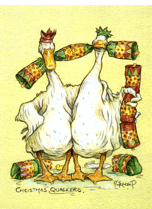 Christmas Quackers
Christmas Quackers
——————————
Why does Santa have three gardens?
So he can Ho Ho Ho
——————————
Why does Santa go down the chimney?
It soots him
——————————
What’s Santa’s favorite cereal?
Frosties
——————————

Where does Santa stay when he travels?At the Ho Ho Hotel
——————————
Why would you remove your door bell?
To win the no bell prize
——————————
How does the Pacific Ocean greet the Atlantic Ocean?
It waves
——————————
What did the snowman say to the other snowman who was standing next to him?
I think I smell carrots
——————————
What do you give a railway station master for Christmas?
Platform shoes
Christmas Crackers — a British Tradition — History and Background
For viewers of this page who are not familiar with the British Christmas tradition of Christmas crackers, we’d like to offer some background.
Christmas crackers are brightly colored paper tubes that are placed on each plate at Christmas parties.

The tube is constructed so that, when pulled on each end, the tube “cracks” open. A paper slip with a joke on it and a paper crown fall out.
Christmas crackers were invented by Thomas Smith in 1846 when he was visiting Paris. He came across a bon-bon, which is a sugar-almond wrapped in tissue paper. Smith began importing bob-bons to England.
The bob-bons sold well in England at Christmas but not at other times of the year.
In the 1850s, Smith started putting mottoes in the bob-bons. As many of the bon-bons were bought by men to give to women, many of the mottos were love poems.
In 1860, Smith added the banger — two strips of chemically impregnated paper that made a cracking sound when pulled apart.
Over time, jokes replaced the love poems.
More information about this can be found on this website: http://resources.woodlands-junior.kent.sch.uk/customs/xmas/crackers.html

——————————









